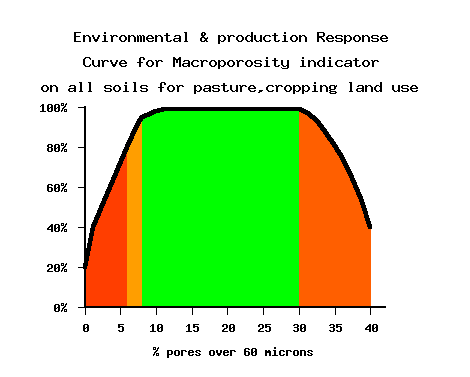What is it?
Macroporosity is a measure of the proportion of large pores in the soil that provide the air supply to roots. The pores are larger than about 60 microns. Soils are comprised of solid material, water and air. Where macroporosity is limited the proportion of air is restricted, and when a low macroporosity soil becomes wet air is excluded and consequently reduced diffusion of oxygen will lead to the onset of anaerobic conditions. Very low macroporosity may limit the extension of roots and drainage of water.
How to interpret it
 High - The soil is loose and may be subject to erosion. Water entry may be rapid
and there is potential for rapid leaching of water through coarse pores of the soil,
bypassing volumes of soil where pores are finer. Pine tree growth may be limited
in some Pumice Soils.
High - The soil is loose and may be subject to erosion. Water entry may be rapid
and there is potential for rapid leaching of water through coarse pores of the soil,
bypassing volumes of soil where pores are finer. Pine tree growth may be limited
in some Pumice Soils.
 Adequate - Air supply to plants is not restricted, unless the soil is naturally
poorly or very poorly drained. Root extension is also not limited.
Adequate - Air supply to plants is not restricted, unless the soil is naturally
poorly or very poorly drained. Root extension is also not limited.
 Low - Plant growth may be affected by reduced oxygen diffusion to roots, and
root extension might be impeded. The growth of young pine trees will be affected.
Low - Plant growth may be affected by reduced oxygen diffusion to roots, and
root extension might be impeded. The growth of young pine trees will be affected.
 Very low - Plant growth may be severely affected by reduced oxygen diffusion to
roots, and root extension may be impeded. Pine forest seedling may die.
Very low - Plant growth may be severely affected by reduced oxygen diffusion to
roots, and root extension may be impeded. Pine forest seedling may die.

How to improve it
Amelioration of low macroporosity soils is the same as for high bulk density soils. Any mechanical impacts should be reduced as much as possible. Clayey soils in particular are more susceptible to changes in pore structure when wet. Planning of grazing and tillage practices during wet weather can help to prevent compaction problems. For example, use of well-drained paddocks or standoff pads during wet weather and limiting traffic to light vehicles such as bikes instead of heavy tractors are examples of practices likely to have beneficial effects.
In heavily compacted soils, drainage may be necessary to establish vigorous vegetation cover. Growing plants add organic matter to the soil through root growth and decomposition of litter, and stimulate increased burrowing activity of the soil fauna. This has the effect of ‘puffing up’ the soil volume and increasing porosity. If necessary, tillage or ripping may break up compacted layers.
Soils with very high macroporosity may need to be mechanically compacted. Continuous vegetation cover offers protection from surface erosion.
Technical details
Historically, macroporosity was defined as the proportion of soil drained between the pressure levels of 0 and –5 kPa on the water desorption curve (equivalent to 0.06 mm pore size). The definition of macropores was recently expanded to cover a larger range of pore sizes and we currently use a definition of soil drained between 0 and –10 kPa (equivalent to 0.03 mm pore diameter). This measurement is sometimes technically referred to air-filled porosity or air capacity. Macroporosity is usually expressed as a percentage of the total volume of the soil.
Reference material
Gradwell, M.W.; Birrell, K.S. 1979: Methods for physical analysis of soils. DSIR,
New Zealand Soil Bureau Scientific Report 10C
Hall, D.G.M.; Reeve, M.J.; Thomasson, A.J.; Wright, V.F. 1977: Water retention,
porosity and density of field soils. Soil Survey Technical Monograph No. 9.
Harpenden, Soil Survey of England and Wales.